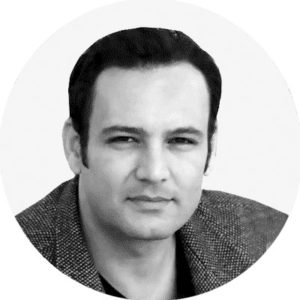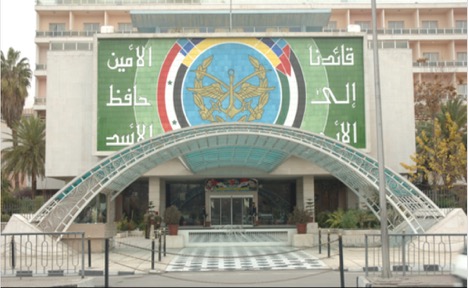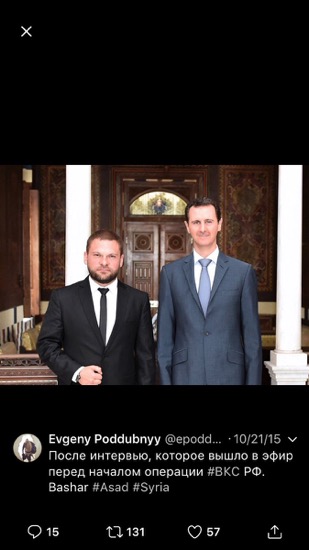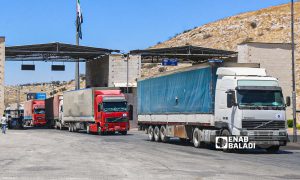Long history of fabricating interviews and blocking the truth
How Credible is the Russian Interviews on Douma’s Chemical Attack?
Mansour Omari
“The plot of the boy from the Syrian Duma will be shown to representatives of the member countries of the UN Security Council, Russian permanent representative to the United Nations Vasily Nebenzia said on Thursday in an interview with Rossiya 1 television channel.” TASS reported on April 19.
Putin’s Russia, who is accused of the assassination of journalists for doing their job in reporting the truth, manipulating the audiences using social media, and faking news, cannot be reliable source of information. This is common sense. 33 journalists were killed in Russia after Putin became the head of FSB, the Russian security agency that succeeded the KGB, in 1998. Including, Anna Politkovskaya, who was known for her opposition to the Chechen conflict and for criticism of Vladimir Putin, and most recently Maksim Borodin, the Russian journalist who covered Wagner Group mercenary, which is operating in Syria, apparently with Putin’s permit, and sponsored by Yevgeny Prigozhin, known as “Putin’s chef”.
Another common-sense fact is that the media outlets which are funded by parties to conflicts are not credible and cannot be a reliable source of information on those conflicts. Would any one imagine that Russian state TV would accuse the Russian government of supporting and covering a chemical attack!
For Example, I reported in 2016, that Arabic Russia Today, known as the Russian propaganda channel, and funded by the Russian government, which is a part of the conflict in Syria, published a video on its website inversing the facts in Syria. In my piece in 2016: “Are Russian Propagandists Manipulating Footage of Syrian Devastation to Save Assad?”, I showed how RT’s published an article headlined: “People Killed and injured by ‘Nusra’ bombing on residential neighborhoods of Aleppo”, with a footage of air shelling by Syrian/Russian war jets, that was originally shot by Hadi Abdullah, a Syrian reporter.
How credible is a Media funded by a conflict party?
The same video that Russia prepared to show in the UNSC, was made by Evgeny Poddubnyy the military correspondent of the state-owned Russia 24 TV, shows also Russian officers entering the gate behind the child and his father, in a military facility called “Damascus Location Officers Club”. This military facility is surrounded by the highest military commands in Syria, like the Airforce Command, and the Syrian army Joint Chiefs of Staff headquarter. In Contrary to what the military correspondent said that he didn’t make the interview in the Military Club, “when asked directly if the piece had been filmed on the grounds of the Syrian Army Officers Club, Poddubnyy said that it had not” according to The Intercept’s article on the video.
Location of the Officers Club:

Screenshot from the interview Video, shows Russian military entering the Officers Club, and its decorated fence
Distortion of evidence like this is of a piece with how Moscow’s media surrogates have depicted the Syrian civil war for five years, but especially since Russia’s intervention in conflict last September on behalf of Assad.
Faking news, videos and interviews on the war in Syria is a whole industry, planned and supervised by intelligence in Russia and Syria. Starting from using video games footage claiming its Russian military perorations in Syria.
Syrian state media has a long history of faking news and interviews. Its editorial line is actually planned and supervised by the Syrian intelligence and the Media Office of the Presidential Palace. Faking news is merely a part of the propaganda campaign or “media attack” as described by Bashar al-Assad of Syria himself, in his Damascus University speech On January 10, 2012. It is a part of the war Assad launched against the Syrians who protested his dictatorship, and against independent media, as he clearly said in the same speech: “there was a repeated question why ‘we were not allowing media to enter Syria’?”.
Imposed self-censorship
One basic component of faking news industry is the self-censorship imposed by Assad regime for decades on the Syrian people. Where every Syrian knows his fate if provided any piece of information that is against or even not in line with the government official stance.
“The only source for news in Syria was to be the official stance, provided by dictations from Syrian intelligence agents who had their hands on the media. Any other element was considered “fabrication” and “against the State” by the Syrian regime and its head” as a Reporters Without Borders’s report described the situation of freedom of opinion in Assad’s Syria. A journalist, an opponent, a citizen, a woman or even a child would not dare to provide facts or express opinions or statements, knowing that Assad regime has killed hundreds of journalists and media activists, including under torture and by assassinating, and not forgetting about Marie Colvin and Remi Ochlik, who were assassinated by Assad forces only because they are reporting from Syria.
This absolute self-censorship, was affirmed also bravely and smartly, yet simply, by Isobel Yeung, a VICE News correspondent, who showed the world “What Life Is Like Inside Assad’s Syria”, and provided examples of intelligence faking scenes for the media, like when a group of supposedly female “fighters” came to be interviewed by her, claiming they are stationed in the frontline to fight for Assad, but they left after the interview. Also, that
Syrian state TVs and media have a long history of fabricating news and coercing interviews under threat of more torture, and depending on the self-censorhsip they successfully managed to spread among the people they control, several of them are revealed.
Walid al-Muallem, the Syrian Foreign Minister aired in 2011, video footage he said showed “terrorist” groups killing Syrian troops in various towns across the country, which appeared later that it was filmed in 2008 during clashes in Lebanon. What triggered a demonstration against al-Muallem in Lebanon.
Anwar O, a TV editor who worked for Addounia TV, Syrian state-supported TV, told me they asked him to make an interview in an Air Force Intelligence office, with woman to claim she was raped by rebels, and help her memorize what she had to say in front of the camera. Anwar helped leak the uncut video that shows her laughing after making a mistake in the interview and saying: “but this is what he wrote”. Anwar left working for Addounia TV later.
Under threat of torture, Shiar Khali, a Syrian reporter, was coerced to be interviewed by the Syrian state TV and say in front of the camera what they prepared for him.
How credible is an interview, made inside a military facility where Russian officers exist, and made by a military correspondent of a state-owned TV channel, inside Syria’s most protected and militarized and horrifying areas?
if you think the article contain wrong information or you have additional details Send Correction
-
Follow us :
Most viewed
- Washington clarifies to Enab Baladi Assad's claims of secret meetings with US officials
- Russian raids around al-Tanf accompanied by accusations against Americans
- Al-Assad issues decree on establishing alternative information ministry
- After controversy over his fate, Ali Mamlouk appears in Russia
- US Senate approves “Captagon II” bill, paving way for presidential signature

















 A
A
A
A
A
A










 More Opinion
More Opinion